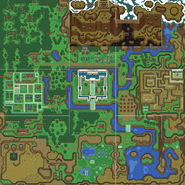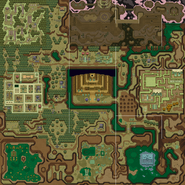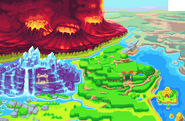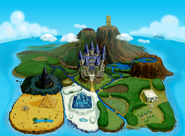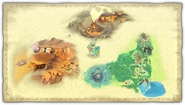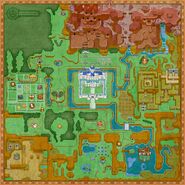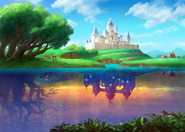- "When all was chaos, the goddesses descended and gave order and life to the world. They granted power equally to all who dwelt in the light, and then returned to the heavens. The lands where the goddesses descended came to be known as the Sacred Realm. For ages, the people lived at ease, content in mind and body..."
- — Lanayru
Hyrule (ハイラル Hairaru?, ![]()
![]()
![]()
![]()
![]()
![]() ) is the name of the mythical kingdom in which a vast majority of games within the Legend of Zelda series take place and serves as the center stage for many of the stories that unfold in the series. While the name of Hyrule applies to Hyrule proper, it can also apply to outlying provinces and territories as well under the rule of the Royal Family of Hyrule.
) is the name of the mythical kingdom in which a vast majority of games within the Legend of Zelda series take place and serves as the center stage for many of the stories that unfold in the series. While the name of Hyrule applies to Hyrule proper, it can also apply to outlying provinces and territories as well under the rule of the Royal Family of Hyrule.
History[]
Spoiler warning: Plot or ending details follow.
Creation[]

The creation of Hyrule by the three Golden Goddesses: Din, Nayru and Farore
Before time began, before spirits and life existed, three Golden Goddesses descended from a Distant Nebula upon the chaos that was Hyrule. These three Golden Goddesses were Din, the Goddess of Power; Nayru, the Goddess of Wisdom; and Farore, the Goddess of Courage.
The Golden Goddesses each infused the land of Hyrule with their own powers. Din, with her strong, flaming arms, cultivated the land and created the red earth. Hence, she created the very earth from which life in Hyrule would spring. Nayru poured her wisdom onto the earth and gave the spirit of law to the world, thus establishing order in a formerly chaotic world. She was responsible for the creation of the laws of the universe, including the laws of science and wizardry that would govern Hyrule and the universe at large. Farore, with her rich soul, produced all life forms that would uphold the law established by Nayru. As the mother of all life in the universe, she created the beings that would walk the earth, fly in the sky, and swim in the waters.

Hyrule at peace as depicted in The Wind Waker
The three Golden Goddesses, their labors completed, departed for the heavens from a parallel dimension connected to the land of Hyrule, a realm of midday golden skies and a place where the spirits could roam free. A temple dedicated to the element of light was set at the heart of this Golden Land and the Goddesses departed from the point atop the pyramidal temple, leaving behind a symbol of their power at the point atop the temple. This symbol, a golden triangle composed of three smaller triangles united to form one, came to be known as the Triforce, a relic of omnipotent and omniscient power.
The Triforce, when mastered in its entirety, would grant its wielder his or her heart's desire for the duration of his or her natural life. It served as a balance of the three forces: Power, Wisdom and Courage. Only one with all three forces in balance in his or her heart would be able to wield the united Triforce and use its true power to govern all. The Golden Land of the Triforce came to be known in the land of Hyrule as the Sacred Realm.
Unfortunately, one life-form attempted to gain the Triforce for his own evil desires, the demon known as Demise. Eventually, the land of Hyrule was overrun by demons, forcing the deity Hylia to send the first Hylians to live in the sky in what would eventually be known as Skyloft. With the Hylians in a safe place, Hylia joined the remaining tribes to battle Demise before turning him into the behemoth known only as The Imprisoned and sealing him within the confines of the Temple of Hylia, which would deteriorate into the Sealed Grounds.
Though Demise was defeated, The Imprisoned proves to be too powerful for the seal to hold him. As a counter, Hylia crafted the Goddess Sword which is placed under the watch of Skyloft and would signify when Demise's seal is close to being broken before discarding her divinity and is reborn generations later as a girl named Zelda. However, the actions of Ghirahim, a being that was originally Demise's sword, forced Zelda to learn of her true nature as she travels back in time to keep Demise at bay until her chosen hero, Link can destroy the fiend.
By the time Link arrives to the moment in time when Zelda enters her suspended animation, Link had infused the Goddess Sword with the three goddesses' flames of purification, transforming it into a weapon infused with the power to banish evil itself, coming to be known as the Blade of Evil's Bane, or more commonly, the Master Sword. Though obtaining the Triforce and using it to destroy The Imprisoned, Ghirahim spirits Zelda into the past to revive Demise there. After the weapon absorbs the last trace remains of the resurrected Demise, the Master Sword is placed into the magical Pedestal of Time within the Temple of Hylia before Link and Zelda return to their time. Soon after, many of Skyloft's residents eventually return to Hyrule. However, in his final moments, Demise stated that his hatred will be reborn and the curse of the Demon Tribe (in the Japanese version) will come for Zelda and Link's descendants to make them suffer.
To seal the gateway to the Triforce's new hiding place, which would later become known as the Sacred Realm, the Ancient Sages, the appointed wielders of the powers of the world's elements by the Goddesses, converted the Sealed Grounds into the Temple of Time, which was constructed around the Pedestal of Time and also modified the Master Sword with the assistance of the Oocca race to act as the key to the Sacred Realm. The Sages then sealed the Grand Chamber of the Master Sword with a mighty stone barrier known as the Door of Time, which was then locked by a seal that could only be broken by one possessing three magical jewels, the Spiritual Stones, and the powerful instrument known as the Ocarina of Time with the knowledge to play the Song of Time. Each of these items were then given to the four major races of Hyrule.
As the ages passed, a catastrophic event known as the Great Cataclysm, in which the Triforce would be shattered and the land of Hyrule would be cast into darkness by the evil that shattered the Triforce was predicted. However, this dark entity would be repelled by a great hero, the Hero of Time, who would wield the Master Sword on the eve of the Cataclysm. The Hero of Time would work with the mythical Seven Sages to banish the dark one and return the light of peace to the land of Hyrule. This legend passed down through time and became myth as well as prophecy, the Prophecy of the Great Cataclysm and the Hero of Time.
Hyrulean Civil War[]
For many ages, each of the races of the land lived in peace. However, knowledge of the mythical Sacred Realm and the all-powerful Triforce contained within spread across the land. Eventually, Hyrule fell into a state of civil war as the peoples fought to gain control of the Sacred Realm and the Triforce within. One tribe, a group of dark magicians, referred to simply as Interlopers, crafted an ultimate weapon, the Fused Shadow, and attempted to use it to seize control of the Sacred Realm and by extension take the Triforce for their own.

The battle for the Sacred Realm, as depicted using characters familiar to Link in Twilight Princess
The threat of the Interlopers and their powerful dark magic became so great that the Golden Goddesses intervened. They commanded the Light Spirits to confiscate the Fused Shadow and banish the Interlopers to a land of perpetual twilight. The Light Spirits obeyed their orders, and the Interlopers were driven into the prison world of the Twilight Realm. There, they gradually evolved due to exposure to the twilight, becoming the Twili race, and eventually let go of their resentment towards the world of light and became more peaceful and humble. The Mirror of Twilight was left as the only portal between the Twilight Realm and Hyrule. The Fused Shadow was shattered into four pieces, one of which was kept by the Interlopers and their descendants. The other three were hidden across the land of Hyrule by the Light Spirits.
The war ended when the King of Hyrule unified the land under one banner. The Hylian Royal Family presided over all the land, with races such as the Zora, Gorons, and Gerudo swearing allegiance to the king. However, Ganondorf, the Gerudo King of Thieves, and also the prophesied incarnation of Demise's hatred, secretly plotted to betray the king and obtain the Triforce so that he might conquer Hyrule for himself.
Timeline Split[]
When the events of Ocarina of Time occurred, the timeline was split into three after Zelda's actions. The one where the Hero of Time disappeared from, known as the Adult Timeline, eventually led to the Great Flood. The one where the Hero of Time went to, known as the Child Timeline, led to the events of Majora's Mask. An alternate timeline where the Hero of Time was defeated, known as the Fallen Hero Timeline, led to the the Imprisoning War. Hyrule continues to decline leaving only the area south of Death Mountain which comes to be known as Lesser Hyrule.
Great Flood[]

When no hero appeared to save them, the Hylians appealed to the Goddesses
Several centuries after the events of Ocarina of Time in the Adult Timeline, the seal on the Sacred Realm weakened and Ganon escaped his imprisonment. Although the citizens of Hyrule prayed to the three Golden Goddesses for the Hero of Time to save them, he did not appear and Ganon resumed control. The people of Hyrule were left with no choice but to appeal to the Goddesses, who flooded Hyrule in an attempt to stop Ganondorf. The surviving population evacuated to the highest grounds of Hyrule, which became the islands of the Great Sea.
Using the Master Sword, a seal was then put on Hyrule Castle, keeping it intact inside a giant bubble beneath the Great Sea, while keeping Ganondorf's powers and his minions dormant. While keeping Ganondorf inside of Hyrule, the seal also kept anything else out, as Hyrule cannot be accessed simply by diving beneath the Great Sea. It instead requires special entry, either by means of ringing the bell atop the Tower of the Gods, a portal, or by holding a shard of the Triforce.
At the end of the events of The Wind Waker, Daphnes Nohansen Hyrule uses the power of the Triforce to wash away the remains of the sunken Hyrule and Ganondorf with it, resulting in the final destruction of Hyrule. With his dying breath, he instructs Link and Princess Zelda to find new land, not to be the old Hyrule, but a new land of their own.
Demographics[]
Government[]
Hyrule is for the most part ruled by the Royal Family of Hyrule, and in most games, Hyrule is ruled by a king. A prevalence in the series is that the monarch of Hyrule in one specific game is usually an unseen character who does not appear physically in the games; however, there are exceptions to this. In Twilight Princess, Princess Zelda is the ruler of Hyrule, as evidenced in several cut-scenes, though Midna still refers to her as a princess. In The Wind Waker, the King of Hyrule is Daphnes Nohansen Hyrule, known better as the King of Red Lions.
Economy[]
The economy of Hyrule has varied throughout installments, although it seems a likelihood that Hyrule's economical value stems from trade and commerce. In Twilight Princess, for example, shops can be found in Hyrule Castle Town among other places, where Link can purchase a variety of goods for a price. As Hyrule Castle Town is the capital of Hyrule in Twilight Princess, it seems obvious that businesses would base their central shops in Hyrule Castle Town, as evidenced by Malo and his ambition to expand his Malo Mart chain of low-priced goods, obviously making Castle Town a priority. Independent small businesses like Sera's Sundries in Ordon Village can be found in across Hyrule, however their prices can range owing to their isolation from other large enterprises.
Though the enterprising Business Scrubs do not appear in towns, they can be found in Kokiri Forest, the Lost Woods, and various Hidden Holes throughout Hyrule. After being defeated, they become more than willing to sell their wares in exchange for Rupees.
Mini-games are another curious economical stimulation; the money gained from them seems mostly personal, as mini-game operators seem to base their businesses solely off of their own funds, rather than owning several locations. The Hyrule Castle Town Shooting Gallery from Ocarina of Time, for example, can be found in Hyrule Castle Town, but after Ganondorf's destruction of Hyrule Castle Town, it relocates to Kakariko Village under the new name of the Kakariko Village Shooting Gallery.
Currency[]
Rupee[]

Artwork of Rupees from A Link to the Past
Rupees are the unit of currency in most regions of Hyrule, as well as other outlying countries. Rupees somewhat resemble crystals and can be found with many different color tints; each with a different value, though the value varies from game-to-game. Rupees are acquired primarily by defeating enemies, cutting tall grass or bushes, or by opening treasure chests, and are used primarily to purchase items in shops, or to play in mini-games and, in rare cases, advance in the game.
Mon[]
Mon is a secondary currency featured in The Legend of Zelda: Breath of the Wild. It is traded in from monster parts by Kilton. Mon is used to purchase monster-related items, weapons and armor from Kilton's shop, Fang and Bone.
Language[]
The language of Hyrule is the Hylian Language (![]() ), which varies from game to game. Its first chronological game appearance was Logographic Hylian, found in A Link to the Past. Later came the Old Hylian syllabary, found in Ocarina of Time, which eventually is replaced by the New Hylian syllabary in The Wind Waker. The most easily translatable version is the most recent Hylian Alphabet of Twilight Princess, which is based off of the real-world English language.
), which varies from game to game. Its first chronological game appearance was Logographic Hylian, found in A Link to the Past. Later came the Old Hylian syllabary, found in Ocarina of Time, which eventually is replaced by the New Hylian syllabary in The Wind Waker. The most easily translatable version is the most recent Hylian Alphabet of Twilight Princess, which is based off of the real-world English language.
Religion[]
Denizens of Hyrule likely worship the three Golden Goddesses who are accredited with the creation of Hyrule in Ocarina of Time, as mentioned in the opening scenes of The Wind Waker. However, in earlier games, like The Legend of Zelda, the religion of Hyrule seems to be Christianity. In "Oracle of Seasons", one girl mentions "Santa". Skyward Sword seems to ignore the divinity of the Golden Goddesses, though their names are often mentioned, and instead the primary religion is worship of the goddess Hylia. Hylia is also the primary deity in Breath of the Wild, where statues of her are found in most major settlements. Many races of Hyrule have their own deities; Lord Jabu-Jabu was the patron deity of the Zora for example. The Light Spirits are also worshiped in Twilight Princess.
Crime, law enforcement, and military[]
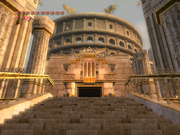
The entrance to the Arbiter's Grounds from Twilight Princess
Law enforcement of Hyrule would likely be left to the Hyrulean Soldiers, who are in the Hylian Army and protect Hyrule. There is a jail on Windfall Island in The Wind Waker that is presumably used to house wrongdoers. In terms of actual law, the Ancient Sages of Twilight Princess were the first group seen to actually enforce corporal punishment to wrongdoers. They presided over the first large-scale prison of any of the games, the Arbiter's Grounds, which housed prisoners like Ganondorf. Additionally, there appear to be remnants of old torture devices and guillotines in places like the Shadow Temple and Bottom of the Well in Ocarina of Time. Hyrule Castle also has a small dungeon facility in Twilight Princess which Wolf Link is imprisoned in, and another prison in Hyrule Castle appears in Breath of the Wild.
In terms of punishment, not much was known as to what punishments were inflicted for crimes, or for what crimes at all. The only knowledge is that people that have committed vile crimes were sentenced to be executed. For very severe crimes, prisoners were sentenced to an eternity in the Twilight Realm, where none could escape.
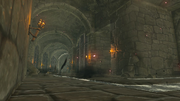
Lockup, the dungeon prison of Hyrule Castle in Breath of the Wild
Technology[]
Technology of Hyrule is primarily medieval; despite this it has varied between the games, and advances can be seen throughout the series. In the earliest games, The Legend of Zelda and The Adventure of Link, for example, little technology is found, save for a few innovations such as bridges and sparse towns. The apparent lack of technology can likely be attributed to the lack of civilization and development in Hyrule, which increased over the span of the games, along with the signs of technology.
In later games like The Wind Waker, for example, primitive technology is still being used, like wind-driven ships, but things like Picto Boxes and lighthouses are found, which show signs of increasing technological advancement. The Wind Temple in The Wind Waker shows many signs of notable advancement, like wind driven objects, while the Earth Temple uses many primitive devices and has an overall barbaric appearance.
The Oocca are described as a very advanced race in many places. It is even believed by some that they created the Hylians many ages ago. When Link goes to the City in the Sky, however, they don't seem much more advanced than Hylians and Humans. They invented cannons many centuries ago, which is a sign of their advanced culture, but Hylians now have use of this technology. It is also believed that they invented the Clawshot, though it is a mystery why, as the Oocca lack the arms needed to use it. Whether they created the City in the Sky or simply live there is unknown.
Skyward Sword, rather oddly, is much more technologically advanced than the other games, despite being a prequel. There is an item called the Beetle, which can be guided though the air in order to to grab items. Another item, the Gust Bellows, is a device capable of shooting out large amounts of wind at high speed, and the Ancient Robots, LD-002G Scervo, LD-003K Dreadfuse and Koloktos are automatons in varying states of disrepair.
Throughout Hyrule, the Sheikah have placed Gossip Stones which will provide information to anyone wearing the Mask of Truth. In the 3DS remake of Ocarina of Time there are also two Sheikah Stones, one located near Link's House in Kokiri Forest while the other can be found inside the Temple of Time.
The Sheikah have a central role in Breath of the Wild, in particular through their ancient technology in which they have created mechanical constructs such as Guardians and Divine Beasts, buildings such as Shrines or Sheikah Towers, various equipment and objects such as the Sheikah Slate and different sets of weapons and armor.
By the time of Breath of the Wild, the method to create rubber is lost, as the Rubber Helm, Armor and Tights are considered to be created from an "ancient technology".
Demonym[]
"Hyrulean" is the term used to describe anyone that lives within the land of Hyrule. This term should not be confused with the term Hylian. People that are Hylian belong to an elf-like race of people that is not exclusive to Hyrule. Hyrulean, on the other hand, means from or related to the mythical land of Hyrule. Unlike Hylians, Hyruleans are anyone who lives in Hyrule regardless of race.
The spelling "Hyrulian" was used interchangeably for "Hyrulean" by fans until Nintendo announced that the latter is the official spelling. In Twilight Princess, the caption for Hena's discussion about her ancestor mistakenly spells the demonym "Hyrulian".
Races[]
The racial division of Hyrule is typically very large, as Hyrule is the large homeland of several races, each very different from the others.
Deku[]
A forest variety of creatures, the Deku can range from friendly to dangerous. They are typically found in the forest, or forest-type terrain areas. In Ocarina of Time, they are typically found in the Kokiri Forest and the Lost Woods. They live in close proximity to the Kokiri.
Gerudo[]
The Gerudo are a secretive race who keep mostly to themselves and reject outsiders. They reside in the Gerudo Desert and Gerudo Valley, in settlements such as Gerudo's Fortress and Gerudo Town. The Gerudo specialize in thievery and are distinguishable by their tan skin. Interestingly, a male is only born unto the Gerudo every one hundred years. The most famous male to surface from the Gerudo is Ganondorf. As most are female, Gerudo women are often depicted as strong and physically imposing Amazon-like women with a generally female dominated culture, due to the rarity of Gerudo males whom are viewed as a rare blessing explaining why Gerudo males traditionally are destined to become King when one is born among the tribe. Due to this, Gerudo women seek out Hylian men as husbands and to reproduce. Gerudo do not tolerate men in their main settlements. In Breath of the Wild, Gerudo are seen to have their own language, with phrases such as 'Vai' for 'woman' and 'Voe' for 'man'.
Goron[]
One of the most prominent races in Hyrule is the proud race of the rock-eating Gorons. This mountain-dwelling race values courage and strength; most Gorons have great strength and muscle mass, and their traditions of sumo wrestling and fighting support this fact. The Gorons typically inhabit Death Mountain, in settlements such as Goron City. The Gorons are exceptional miners; the Goron Mines are a primary source of Hyrule's precious gems and metals. They are generally very welcoming to outsiders despite living in environments inhospitable to most other races and often travel from their mountain homes to trade.
Hylian[]
The Hylians are easily the largest and most common race in Hyrule, not including certain areas in Twilight Princess where they are few. They are the founders and rulers of Hyrule by divine right, being the chosen race of the Goddesses. Their physical appearance is very similar to that of humans, distinguishable only by their pointed ears. They have magical abilities, with some of them (such as Link) also having superhuman strength. In Twilight Princess, it is mentioned that the Hylians were possibly created by the Oocca race. The Hylians live in various locations around Hyrule, and many more can be found in Hyrule Castle and Hyrule Castle Town.
Kokiri and Korok[]
The Kokiri are a race of children who never age. They dwell within Kokiri Forest under the protection of the Great Deku Tree. Each Kokiri has a guardian fairy to protect and guide him or her. Despite never aging, Kokiri appear very similar to Hylian people, with pointed ears and human features. The orphaned Hero of Time was raised as a Kokiri. The Kokiri are very possibly forest spirits, as they changed their appearance in order to adapt to the new world caused by the Great Flood, appearing as Koroks in The Wind Waker. It is currently unknown what happened to them in the Child Timeline and Fallen Hero Timeline. Koroks also appear in Breath of the Wild where the Kokiri are absent. Koroks are small, sapling like creatures with leaf faces, who like the Kokiri are very childlike in nature. They primarily live with the Great Deku Tree in the Forest Haven and Great Hyrule Forest, however many can be found scattered across Hyrule in Breath of the Wild hiding under rocks and in stumps.
Sheikah[]
Also known as the Shadow Folk, the Sheikah are an ancient clan of ninja-like warriors that serve the Royal Family, even after death. Because of this they came to be known as "the Shadows of the Hylians." They were skilled in magical and combative art. It is assumed that many died during the Hyrulean Civil War. The race grew ever more rare after the Imprisoning War and were presumed extinct after the Great Flood. It was shown however, that the Sheikah still exist in the Child Timeline and Fallen Hero Timeline. In Breath of the Wild the Sheikah reappear in great numbers, having their own established settlement in Kakariko Village. Here, the Sheikah are shown to be a technologically advanced race in the past creating technologies such as Runes and Guardians. A faction of the Sheikah known as the Yiga Clan sides with Ganon, due to the oppression and mistrust of Hylians.
Zora[]
The Zora are a race of humanoid aquatic creatures that usually inhabit Lake Hylia, more specifically upriver at Zora's Domain. Zora live especially long lifespans of over one hundred years and can be very proud and aloof. The Zora are led by their own Royal Family; however, they also swear allegiance to the Royal Family of Hyrule. Their Domain is a grandiose and beautiful sub-aquatic city, with shops, inns and residences.
Rito[]
The Rito are a race of humanoid birds that reside at Rito Village of the Tabantha Frontier region located in the Western Hebra province of Hyrule. They first appeared in The Wind Waker in which they lived on Dragon Roost Island, where they were evolved from the Zora after the Great Flood. The Rito in The Wind Waker are more humanoid and are not born with wings, while the Rito in Breath of the Wild are more akin to anthropomorphic birds, born with prehensile wings that double as arms. In Breath of the Wild, Rito and Zora exist together as seperate species unlike in The Wind Waker. Rito have a proud warrior culture and specialize in aerial combat. Rito also have a fondness for music with some even becoming minstrels and children sing in choirs. Rito Village is open to tourism and Rito are quite friendly.
Human[]
Humans are a race most commonly seen in The Legend of Zelda: Twilight Princess at Ordon Village and make up most of the population of the village. Link is the only Hylian in the village. They resemble Hylians in most ways, the most easily recognized difference is the ears. Hylians have bigger, pointy ears, while Humans have more rounded ears. This is a race not seen in most games. The only games in which they make an appearance are The Legend of Zelda: A Link to the Past, The Wind Waker, and Twilight Princess. In the games where they appear, they and Hylians are often confused for each other.
Geography[]
The geography of Hyrule remains different for each region of Hyrule. The Peak Province in Twilight Princess, for example, is very cold and icy, while the neighboring Desert Province is hot and arid. It is unknown how this is possible considering the very different climates in each locations.
Common landmarks[]
Hyrule Field[]

Hyrule Field from Twilight Princess
Hyrule Field is the central landmark of Hyrule. It is a large, expansive field off of which most other areas of Hyrule branch. Because of its immense size, Hyrule Field is easiest to traverse while riding a horse. Small groups of trees and brush are scattered sparsely throughout along beaten paths. Various enemies can be found throughout Hyrule Field, including Stalchildren, Peahats, Poes, and Kargarocs. During Zant's Invasion of Hyrule, this is where Link faces off against Ganondorf to defend Hyrule. In some games, Lon Lon Ranch can be found at the center of Hyrule Field.
Death Mountain[]

Death Mountain from Ocarina of Time
Death Mountain is a volcanic mountain that usually can be accessed only with the Royal Family's permission. This region of Hyrule is regularly inhabited by the Gorons, a proud, rock-eating race. The cloud around the very top of Death Mountain serves as an "indicator" of sorts of the state of the volcano. In earlier games, it was usually the location of Ganon's hideout.
Lake Hylia[]

Zora's Domain from Ocarina of Time
Lake Hylia is the largest body of water in Hyrule in the games it appears in. The water from Zora's Domain runs throughout Hyrule, into this pristine lake. Lake Hylia is frequently a sacred location for certain races of Hyrule.
Zora's Domain[]
Zora's Domain, the aquatic home of the Zora, is located in the eastern Lanayru Province of Hyrule. It is generally very difficult to access Zora's Domain, as Link must hold great endurance or knowledge to enter. Zora's Domain is connected to Lake Hylia by Zora's River. It can also be accessed from the Lost Woods and Lake Hylia by means of an underwater passage. The domain has been frozen over various times, requiring Link to thaw it out.
Zora's Domain is inhabited by King Zora, Princess Ruto, Lord Jabu-Jabu, Prince Ralis, and various other Zora.
Hyrule Castle[]

Hyrule Castle from Twilight Princess
Hyrule Castle is the home of the Royal Family of Hyrule. The castle's first appearance was in A Link to the Past. Each game that contains a Hyrule Castle either features a different layout, or denies the player access to parts that are available in other games. There are grounds for speculation that the castle is actually a different castle in each game, or that it is the same castle but was changed in each game for aesthetic or gameplay purposes.
The castle itself is prone to conflict not only because it houses the head of Hyrule's government, but also because its security is often less than impenetrable. In fact in many of the games Link took advantage of this and was able to sneak into the castle despite all of the security. Hyrule Castle is fairly important in most of the games it has appeared in and is often shown as a dungeon or a level within these games.
Hyrule Castle Town[]

Hyrule Castle Town from Ocarina of Time
Hyrule Castle Town is a town that is situated right in front of the castle. Many people live there. The capital city and commercial center of Hyrule, it is located in the far north of Hyrule, bordering to Hyrule Field to the south. Being a castle town, it is surrounded by a huge, impenetrable wall, and can only be accessed by a drawbridge which is lowered only at daytime. The source of the moat surrounding the castle town's walls is Zora's River.
Hyrule Castle Market is a crowded place at daytime, with bustling crowds of people of all Hyrulean walks of life all around. Businesses like the Happy Mask Shop, the Bazaar and the Bombchu Bowling Alley are also open exclusively during the day. There is also a less crowded back alley in the town with the occasional loiterer. At night, packs of stray dogs appear in the nearly deserted market. Some more questionable shops like the Treasure Box Shop and Bombchu Shop are also open during nightfall.
On the edge of the town can be found the Temple of Time, a huge stone temple guarding the Master Sword, and also, the entrance to the Sacred Realm where the Triforce lies. When Link pulls out the Master Sword in Ocarina of Time, his spirit is sealed within the Sacred Realm for seven years, in order for him to become the Hero of Time. When he awakens, he finds that Hyrule Castle Town has been destroyed by Ganondorf, the King of Evil. Some of the inhabitants were able to escape to the nearby Kakariko Village, and the ruined city became haunted by ReDeads. It is unknown whether any Hyrule Castle Town citizens were actually killed in the attack.
Hyrule Town is a location in The Legend of Zelda: The Minish Cap. It is here the festivities for the annual Picori Festival are held. The city is large and busy. The Mayor is Mayor Hagen.
Kakariko Village[]
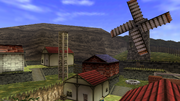
Kakariko Village from Ocarina of Time
Kakariko Village was once a village full of the Sheikah, but they eventually died out and Impa let other people live in the village. It is a recurring location in the Legend of Zelda series. Its geographical and historical situation seems to change in each game, and so many fans assert that these villages are not the same, but merely share the same name. It may have been inspired by various towns in Zelda II: The Adventure of Link, and in turn may have served as the inspiration for such future towns in the series - Mabe Village, Clock Town, Lynna City, Horon Village, Windfall Island, Hyrule Town, and various minor villages (i.e. Symmetry City).
Appearances[]
The Legend of Zelda[]
Compared to other depictions of Hyrule, southern Hyrule in the original The Legend of Zelda was smaller than in later games of the series, in terms of overall relative scale. There are no towns or civilizations in the far south (the region where The Legend of Zelda: Ocarina of Time, The Legend of Zelda: Twilight Princess, and The Legend of Zelda: A Link to the Past are set), only several caves containing dungeons. Shigeru Miyamoto states that this version of Hyrule is based on the area of his homeland when he was a child, including the caves placed throughout the land.
Zelda II: The Adventure of Link[]
Hyrule in The Adventure of Link appears larger than other appearances of Hyrule in other games. Many towns in Hyrule later came to be names of the Seven Sages in Ocarina of Time. Many more landmarks could be found in this Hyrule, such as mountains, caves, forests, capes, and even islands. The Hyrule from the first game has a brief cameo as part of the Death Mountain area at the very south.
The Legend of Zelda: A Link to the Past[]
The third game in the Legend of Zelda series takes place yet again in Hyrule, this time in a much more developed land. The Hyrule of A Link to the Past contains many landmarks that would become common in later games, such as Kakariko Village and Hyrule Castle.
A Link to the Past also notably featured the Light World and the Dark World, both of which are depictions of Hyrule, and while they remain geographically similar, up close they appear very different.
The Legend of Zelda: Ocarina of Time[]
Hyrule makes its first appearance in 3D in The Legend of Zelda: Ocarina of Time. In this game, Hyrule is split up into a round field named Hyrule Field, with various lands off to sides, such as the Kokiri Forest and Gerudo Valley. This Hyrule looks radically different than previous depictions of Hyrule, with developed civilizations, rather than a few towns as seen in The Adventure of Link, for example.
Hyrule in Ocarina of Time is the second game to feature Hyrule twice; once in the child timeline of events; a Hyrule on the brink of war; and the Hyrule in the adult timeline; nearly destroyed, desecrated and cursed.
The Legend of Zelda: Majora's Mask[]
Majora's Mask starts off with Link in the Lost Woods, though it is in a forested region never seen before. He is ambushed by the Skull Kid and his fairy friends Tatl and Tael. They steal Link's Ocarina of Time along with his horse Epona, and run off. Link chases after them, and at some point during the chase, he falls into the parallel world of Termina.
The Legend of Zelda: Oracle of Ages and Oracle of Seasons[]
Link is depicted riding through Hyrule in the opening of both games. The only building seen is a large temple or castle where Link discovers the Triforce.
The Legend of Zelda: Four Swords[]
Four Swords only takes place in a small portion of Hyrule, namely the Sea of Trees, a grassy forested stage; Talus Cave, a cavern similar to the Ice Cavern; Death Mountain, a volcanic mountain; and Vaati's Palace, a large structure built in the sky.
The arrangement of this part of Hyrule is conspicuously similar to that of New Hyrule in The Legend of Zelda: Spirit Tracks.
The Legend of Zelda: The Wind Waker[]

Sealed Hyrule in The Wind Waker
Little of The Wind Waker actually takes place in Hyrule, as it is sunken beneath the Great Sea sometime after the events of The Legend of Zelda: Ocarina of Time. However, the Great Sea has many islands that bear remarkable similarity to other various locations that were seen in Hyrule, like Windfall Island and Kakariko Village, and Dragon Roost Island and Death Mountain, which seems plausible as after the Great Flood of Hyrule, the denizens of Hyrule resorted to living on mountaintops, which are mentioned to have become the islands of the Great Sea.
When Link does visit Hyrule, it looks unlike any other appearances of it to date. Link lands in a small pool of water outside of Hyrule Castle, which appears atop a small island in the middle of what seems to be a lake. After exiting the castle, Link can only walk along a small path connecting Hyrule Castle to Ganon's Tower. With the use of a glitch, however, it becomes possible to roam about the grassy fields that contain no towns or villages.
Before the final battle, The King of Hyrule wishes on the Triforce for the last of Hyrule to be completely flooded out of regret for clinging to the past so long. After defeating Ganondorf, Hyrule is completely submerged.
The Legend of Zelda: Four Swords Adventures[]
The Hyrule found in Four Swords Adventures contains many similar landmarks to those found in A Link to the Past renamed as different structures or locations. Examples include the Desert of Doubt, the Lost Woods, and the Tower of Flames.
The Realm of the Heavens, a large kingdom in the sky, can only be accessed by placing the four Royal Jewels in their respective places in the Four Sword Sanctuary, causing the Tower of Winds to appear.
The Legend of Zelda: The Minish Cap[]
In The Minish Cap, Hyrule returned to an appearance similar to A Link to the Past. Many of the landmarks returned; however, they appeared under different names, like the Minish Woods in place of the Lost Woods and Mount Crenel in the position of Death Mountain. It was also the second chronological game to feature an area floating above Hyrule, the Cloud Tops.
Alternatively, the geography could correspond with that of Ocarina of Time: Mount Crenel may well have eroded over centuries into the Gerudo Desert found in Ocarina of Time, a rise in water level would turn the marshlands which already have a geographic and physical resemblance to Lake Hylia into the famous lake, and the mountain Biggoron lives upon may be a precursor to Death Mountain.
The Legend of Zelda: Twilight Princess[]
Hyrule is the vast land where the events of Twilight Princess take place. In this game, Hyrule looks much different than any of its previous appearances, and is split up into provinces, six in all. Provinces and locations bear resemblance to their Ocarina of Time counterparts that appeared in roughly the same geographical location, such as the Gerudo Desert being in the same proximity as the Haunted Wasteland.
The Legend of Zelda: Skyward Sword[]
Hyrule is known only as The Surface, as the kingdom of Hyrule is yet to be established. A land found beneath the Cloud Barrier that separates it from The Sky, it is heavily populated by monsters, as well as creatures such as Mogma and Parella. The Surface is divided into three provinces: Faron Woods, Eldin Volcano, and Lanayru Desert.
Humorously, when Groose follows Link to The Surface he names the Surface, Grooseland after himself, though Groose is the only one to refer to it as such.
The Legend of Zelda: A Link Between Worlds[]
Hyrule is the same world as that depicted in A Link to the Past. It is revealed to have a darker parallel counterpart known as Lorule ruled by Princess Hilda of the Royal Family of Lorule. Lorule even has an inverted Triforce that was the source of much conflict that the Royal Family of Lorule destroyed it inadvertently causing Lorule to become unstable and fall to ruin. It is possible to travel between the two realms via Fissures found in the surfaces of both worlds. .
The Legend of Zelda: Breath of the Wild[]
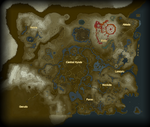
A map of Greater Hyrule from Breath of the Wild
Hyrule is in a state of decay during Breath of the Wild. Link can explore much of Hyrule as soon as he leaves the Shrine of Resurrection and the Great Plateau. The Hyrule portrayed in this game is the largest explorable Hyrule to be featured in any game of the series. Hyrule is mainly divided into eight provinces: Akkala, Central Hyrule, Eldin, Faron, Gerudo, Hebra, Lanayru, and Necluda. Another notable difference from previous games is the appearance of multiple seas within Hyrule. According to the Old Man, the Kingdom of Hyrule was originally founded upon the Great Plateau and the Temple of Time located there was once a site of pilgrimage.
In the Hyrule Compendium, the term Greater Hyrule is used to refer to Hyrule as a whole and is often listed in entries of animals, items, and enemies that can be commonly found all over Hyrule.
Other appearances[]
Subseries warning: This article or section contains information on a subseries within the Legend of Zelda series and should be considered part of its own separate canon.
BS The Legend of Zelda[]
Being a remake of the original The Legend of Zelda, this game features the same Overworld located within Hyrule.
BS The Legend of Zelda: Ancient Stone Tablets[]
As a sequel to A Link to the Past, this game features the incarnation of Hyrule with some minor changes. Initially the entirety of the map is not available to the player but with each successive week, more and more of it becomes unlocked.
Link's Crossbow Training[]
Set in Hyrule from Twilight Princess, the game features several locations such as Ordon Village, Ordon Ranch, Kakariko Village, Hyrule Field, Great Bridge of Hylia, Hyrule Castle Town, Snowpeak, and Gerudo Desert.
Hyrule Warriors[]
As its name implies, Hyrule is the main setting of the non-canon spin-off Hyrule Warriors.
The present day version of Hyrule that appears in the game, consists of stages: Hyrule Field (Hyrule Castle appears as part of the stage which is later transformed into Ganon's Tower by Ganondorf), Eldin Caves, Faron Woods, Temple of the Sacred Sword, Valley of Seers, Temple of Souls, and Gerudo Desert. After Cia uses the Triforce to warp time and space, Death Mountain (along with Goron City) and Lake Hylia (which includes the Water Temple and frozen Zora's Domain) from Ocarina of Time, Twilight Field (a scaled down version of the Eldin Province) and Palace of Twilight from Twilight Princess, and the Sealed Temple and Skyloft from Skyward Sword appear transforming the modern landscape it a warp version of Hyrule made of different Eras and timelines. Following the defeat of Cia, Princess Zelda joins Link and Lana in restoring Hyrule to its original state. However Ganondorf returns and obtains the complete Triforce, which he uses to transform Hyrule Field into a hellish landscape and Hyrule Castle into Ganon's Tower. The Hyrulean Forces eventually capture Ganon's Tower, restoring it back into Hyrule Castle. Following Ganon's defeat, Hyrule Castle and Hyrule Field shown to be damaged and battle scarred from the battle.
In Adventure Mode, the main and Master Quest DLC maps are based on the original map of Hyrule from The Legends of Zelda. The Twilight Princess DLC map is an 8-Bit version of Hyrule from Twilight Princess.
Hyrule Warriors Legends[]
At the beginning of Linkle's Tale, Linkle's Village and house appear to located somewhere within the present day Hyrule and after hearing of the Dark Forces attack on Hyrule Castle she leaves her village to go to Hyrule Castle, however she ends up going down the wrong road and ends lost in Faron Woods. Due to her poor sense of direction and Cia's warping of the land of Hyrule, Linkle ends up in various places such as Lake Hylia, the Sealed Grounds, Palace of Twilight, before eventually reaching Hyrule Field, which she finds transformed into Ganon's Tower. Most of the stages from Hyrule Warriors remain largely unchanged save for a few minor alterations (such as the design of the Knight Academy Keep in Skyloft and the addition of Owl Statues as warp points for the new Ocarina item). However certain story scenarios feature alternate versions of stages, such as Lake Hylia at sunset (Linkle's Tale: Powers Collide), a dark sky over the Sealed Grounds (Linkle's Tale: The Demon Lord's Plan), and clear blue sky over the Valley of Seers (March of the Demon King). Additionally, during the new Era of the Great Sea story line that appears after the main story line, Phantom Ganon steals the Triforce of Power and uses it to warp time and space, causing merged versions of locations from the Great Sea to appear in Hyrule as two stages: Forsaken Fortress (a stage made up of Dragon Roost Island, Forsaken Fortress, Star Island, and Windfall Island) and the Wind and Earth Temples (a merged version of the Wind and Earth Temples).
Subseries warning: Subseries information ends here.
Non-canonical appearances[]
Non-canon warning: This article or section contains non-canonical information that is not considered to be an official part of the Legend of Zelda series and should not be considered part of the overall storyline.
Super Smash Bros. series[]
In Super Smash Bros., Hyrule Castle appears as a stage. In Super Smash Bros. Brawl, the Bridge of Eldin appears as a stage. In Super Smash Bros. for Nintendo 3DS / Wii U, Gerudo Valley appears as a stage in the 3DS version and Bridge of Eldin appears as a stage in the Wii U version. The original Hyrule Castle from Super Smash Bros. appears as DLC.
Cadence of Hyrule[]
Hyrule is the setting for Cadence of Hyrule, a game in the Crypt of the NecroDancer series.
Non-canon warning: Non-canonical information ends here.
Theories[]
Theory warning: This section contains theoretical information based on the research of one or several other users. It has not been officially verified by Nintendo and its factual accuracy is disputed.
Hyrule's shifting geography[]
While certain landmarks of Hyrule commonly return each installment, Hyrule's geography appears to be laid out differently with almost every new game set in it. Parts of Hyrule found in one game's map may be in a different location, have different geographical features, or be completely absent in another. While some games may take into account the geography in past Zelda games (A Link to the Past and Four Sword Adventures share almost the same Hylian geography) others may completely ignore them. The most notable of these differently arranged landscapes is Hyrule from The Minish Cap, which bears almost no resemblance to any other game.
Several fan explanations have been given to explain the changing layout. In Minish Cap's case, the game takes place very early on in the timeline (possibly not long after Hyrule was first properly founded) so the royal family could have possibly switched locations before the events of Ocarina of Time. After this, it could be considered that the changes seen in all games occur due to geological events between the games such as earthquakes, mudslides, erosion, forest growth, continental drift, or all of the above. The second theory is that Hyrule's geography stays relatively the same, but that each new game shows the same Hyrule seen from a different angle, landmarks are renamed, or that other unseen parts of Hyrule are seen each game.
From a more realistic perspective, Hyrule's climate changes from game to game simply due to gameplay reasons, giving players something new to explore while staying in the same land and has no real in-game explanations.
While the geography is always changing, different parts of Hyrule depicted in previous/future Zelda games are possibly shown on occasions. The in-game map for Zelda II: The Adventure of Link has an area that resembles a scaled down version of the map in The Legend of Zelda. The geography then allows the map from A Link to the Past to be included to the west.
Another hugely notable case of geographical similarities lies within The Wind Waker. The Great Flood that causes the ocean climate in The Wind Waker takes place after the events of Ocarina of Time (In the Adult Timeline) and as a result, the layout of locations revealed/speculated to be ones from Ocarina of Time are the same. For example, the Forest Haven, which is speculated to have once been the Kokiri Forest[1], remains at the south-eastern end of The Wind Waker's map, as Kokiri Forest did. Death Mountain, or as it appears in The Wind Waker, Dragon Roost Island, also remains at the north-eastern part of the map, as it did in Ocarina of Time. This also matches up the locations of both Windfall Island and Kakariko Village, two similar villages that both lie at the south-western end of Dragon Roost and Death Mountain respectively. The Forsaken Fortress, Ganon's base of operations, is speculated to have been the Gerudo Valley, and this holds further truth as the fortress appears to remain at the north-western end of the sea. While these similarities may not have been entirely intentional, the strong links these locations possess anyway could grant truth to these coincidences. While it isn't exactly clear where Hyrule Castle is in regards to the map in The Wind Waker (as it resides completely underwater) the Tower of the Gods, the gateway to sunken Hyrule, does stand somewhat near the centre point of the other key locations, vaguely where Hyrule Castle would have been (west end of Death Mountain/Dragon Roost) As a result it could be argued that Hyrule Castle in The Wind Waker does in fact stand, at least under The Great Sea, where it did in Ocarina of Time.
Obviously, in the case of The Wind Waker, due to the entire kingdom having sunk to the bottom of the Great Sea, the exact spots of the locations do not correlate perfectly. All the player can see of Hyrule are the areas tall enough to survive the depth of the water. Despite this, however, a clear link is there.
While Twilight Princess does take place a great deal of time after Ocarina of Time (In the Child Timeline) the map in Twilight Princess still bares a few similarities. Lake Hylia is almost exactly where it was in Ocarina of Time (the south-west corner from Hyrule Castle by Hyrule Field, at least in the Gamecube and Wii U release) and Gerudo Desert still resides at the western end of Hyrule, although it now resides on the south-western edge behind Lake Hylia, which is very slightly off. Kokiri Forest and Lost Woods also presumably remain at the south-eastern corner of the map, although the forest has vastly grown in size since and is inaccessible. Despite these visible similarities in regards to geography, the locations of man-made settlements have changed drastically since Ocarina of Time. Castle Town has switched to the right hand side of Hyrule Castle, and Kakariko Village and the Temple of Time have since separated to far corners of Hyrule. If the Sacred Grove is in actuality the same location as the Lost Woods, then there have been some drastic geographic changes as well.
In Breath of The Wild, Hyrule on the other hand proves to be a very ambiguous and difficult to determine landscape in regards to the locations in previous games. Hyrule, or rather the areas of Hyrule the player is allowed to explore, has expanded in size a great deal. The world of Breath of The Wild possesses both the biggest differences in landscape, but also some of the most undeniable proof of returning locations to date. Both the Temple of Time and what appears to be Hyrule Castle Town from Ocarina of Time now exist in almost exact size and shape in the central area of the Great Plateau, but they now exist much further away from Hyrule Castle, (implying perhaps that a newer, larger castle was built in a new location) Death Mountain still exists on the upper eastern side of Hyrule Castle (albeit the new Hyrule Castle) but it now stands at a much taller and wider size, and the distance is comparatively much further away.
According to the Old Man, the Great Plateau is where the Kingdom of Hyrule was original founded long ago and that the Temple of Time was a place of pilgrimage. During the current events of Breath of the Wild, the Great Plateau became completely isolated and mostly abandoned. Though difficult, it is possible to climb or fly up to reach the Great Plateau, though most tend to avoid the area due to its isolation and having little to offer.
Other areas such as Lake Hylia and Gerudo Desert are shown close to one another, similar to how they were depicted in past games. Several areas and locations from past games are referenced in Breath of the Wild such as the Arbiter's Ground, Faron Woods, Lake Floria, and Mabe Village Ruins, though it is unclear if they are the Breath of the Wild incarnation of those places or simply references to places from past games.
Spectacle Rock is shown to be near Gerudo Canyon in the Gerudo Highlands located west of Gerudo Desert. Additionally, the layout of the Ranch Ruins in Central Hyrule is nearly identical to Lon Lon Ranch, though it is unknown if it is meant to be the ruins of the Breath of the Wild incarnation of Lon Lon Ranch or just another reference. It should be noted that the Ranch Ruins are located on the eastern side of Hyrule Field, which is opposite of where Lon Lon Ranch was in Ocarina of Time, though does match Lon Lon Ranch's general location in The Minish Cap.
In addition to Central Hyrule, Lanayru, Faron, and Eldin provinces, Breath of the Wild introduces several new provinces such as Akkala, Necluda, and Hebra. Gerudo Desert and Gerudo Highlands regions are considered a part of the province of Gerudo with the Gerudo Highlands surrounding the desert from the north and east. It is also shown that there is a snowy mountains in the Gerudo Highlands north of the desert of Hyrule.
The Gerudo Desert in Breath of the Wild is occasionally beset by sandstorms similar to those of the Haunted Wasteland, which was one of the few places that could not be fully explored in Ocarina of Time. There is also an invisible boundary that prevents Link from venturing beyond the boarders in the southern and western parts of the desert due to the sandstorms. The Bridge of Hylia spans over Lake Hylia like it did in Twilight Princess and the remains of a giant tree (which may represent the giant tree from Twilight Princess) can be found near the flooded Deya Village Ruins, located northeast of Lake Hylia.
Faron Woods and Lake Floria are shown to be located in southeastern portion of Hyrule which is depicted as a tropical jungle with ancient ruins. Zora's Domain appears in the Lanayru Great Spring region of Lanayru province, though it is implied that Zora's Domain was founded there 10,000 years before Breath of the Wild, indicating the possibility that Zora were forced to abandon the original Zora's Domain and resettle in Lanayru Great Spring.
These ambiguous yet clear similarities are only further complicated when Breath of The Wild's timeline placement is considered. Not only does Breath of the Wild not possess a confirmed place in the timeline, but the story itself takes place a century after a chaotic period that is not shown in any previous games.
One potential explanation for the shifting geography may be the result of conflicts over the Triforce which have caused much destruction and calamity, leaving Hyrule to rebuild itself. Considering how many villains in the Legend of Zelda series are shown capable of causing devastation to the land of Hyrule itself, it would stand to reason that their actions are the main cause for Hyrule`s shifting geography.
This also leads to the possibility that the Triforce has been used to restore Hyrule once said conflicts have been resolved. Thus the nature of each wish may alter Hyrule for better or worse, resulting in occasional shifts in geology.
Theory warning: Theories end here.
Etymology[]
It is possible that the name "Hyrule" is a play on the pairing "High Rule," referring to the established monarchy of the nation, the order of sages, or the rule of the goddesses themselves. It could also be a play on "Hylian Rule", considering Hylians are the chosen race of the Goddesses.
Notes and references[]
Gallery[]
| Characters |
| Ganon · Link · Old Man · Princess Zelda —Full list of characters |
| Bosses |
| Aquamentus · Dodongo · Manhandla · Gleeok · Digdogger · Gohma · Gannon |
| Locations |
| Lake Hylia · Lost Hills · Lost Woods · Death Mountain · Graveyard · Spectacle Rock —Full list of locations |
| Dungeons |
| First Quest |
| Level 1 · Level 2 · Level 3 · Level 4 · Level 5 · Level 6 · Level 7 · Level 8 · Level 9 |
| Second Quest |
| Level 1 · Level 2 · Level 3 · Level 4 · Level 5 · Level 6 · Level 7 · Level 8 · Level 9 |
| Equipment |
| 2nd Potion · Arrow · Blue Candle · Blue Ring · Bomb · Book of Magic · Boomerang · Bow · Food · Letter · Life Potion · Magical Boomerang · Magical Key · Magical Rod · Power Bracelet · Raft · Recorder · Red Candle · Red Ring · Silver Arrow · Stepladder |
| Items |
| Wooden Sword · White Sword · Magical Sword · Small Shield · Magical Shield |
| Quest Items |
| Triforce of Wisdom |
| Races |
| Fairy · Gerudo · Hylian |
| Characters |
| Dark Link · Ganon · Link · Princess Zelda —Full list of characters |
| Bosses |
| Horsehead · Helmethead · Rebonack · Carock · Gooma · Barba · Thunderbird · Dark Link |
| Hyrule |
| Western Hyrule · Eastern Hyrule · Lesser Hyrule · Maze Island —Full list of locations |
| Dungeons |
| Parapa Palace · Midoro Palace · Island Palace · Maze Island Palace · Ocean Palace · Hidden Palace · Great Palace |
| Equipment |
| Items |
| P Bag · 1-up Doll · Magical Sword · Magical Shield · Candle · Flute · Handy Glove · Hammer · Raft · Boots · Magical Key · Cross |
| Spells |
| Fairy Spell · Fire Spell · Jump Spell · Life Spell · Reflect Spell · Shield Spell · Spell Spell · Thunder Spell |
| Quest Items |
| Trophy · Water of Life · Kidnapped Child · Six Crystals · Triforce of Courage |
| Races |
| Fairy · Hylian |
| Characters |
| Link (x4) · Princess Zelda · Vaati —Full list of characters |
| Bosses |
| Deguchitato · Derazoru · Gouen · Vaati |
| Stages |
| Chambers of Insight · Sea of Trees · Talus Cave · Death Mountain · Vaati's Palace · Hero's Trial · Realm of Memories —Full list of locations |
| Equipment |
| Weapons |
| Bomb · Boomerang · Bow · Bow-Wow · Four Sword · Shield |
| Items |
| Armor Seed · Fairy · Gnat Hat · Heart · Heart Container · Magnetic Glove · Pegasus Boots · Razor Seed · Roc's Cape · Rupee · Pegasus Seed · Small Key |
| Quest Items |
| Golden Key · Hero's Key · Medal of Courage · Silver Key |
| Characters |
| Main Characters |
| Link (x4) · Princess Zelda · Six Maidens · Vaati —Full list of characters |
| Bosses |
| Phantom Ganon · Helmaroc King · Stone Arrghus · Jalhalla · Dagtail · Frostare · Big Dodongo · Vaati · Ganon |
| Levels |
| Whereabouts of the Wind · Eastern Hyrule · Death Mountain · Near the Fields · The Dark World · The Desert of Doubt · Frozen Hyrule · Realm of the Heavens —Full list of locations |
| Equipment |
| Weapons |
| Bomb · Bombos Medallion · Boomerang · Bow · Fire Rod · Four Sword · Lantern · Magic Hammer · Quake Medallion · Shield · Slingshot |
| Items |
| Blue Bracelet · Carrot · Force Gem · Force Fairy · Heart · Heart Container · Moon Pearl · Pegasus Boots · Power Bracelet · Roc's Feather · Shovel · Small Key |
| Quest Items |
| Knight Mark · Letter · Magic Book · Royal Jewels · Vaati Barrier |
| Races |
| Gerudo · Goron · Hylian · Zuna |
| Characters | ||
| Ezlo · King Daltus · Link · Princess Zelda · Smith · Vaati —Full list of characters | ||
| Bosses | ||
| Big Green ChuChu · Gleerok · Mazaal · Big Octorok · Gyorg Pair · Vaati Reborn · Vaati Transfigured · Vaati's Wrath | ||
| Locations | ||
| Castor Wilds · Cloud Tops · Eastern Hills · Hyrule Town · Lake Hylia · Lon Lon Ranch · Minish Woods · Mount Crenel · Mt. Crenel's Base · North Hyrule Field · Royal Valley · South Hyrule Field · Trilby Highlands · Veil Falls · Western Wood · Wind Ruins | ||
| Dungeons | ||
| Deepwood Shrine · Cave of Flames · Fortress of Winds · Temple of Droplets · Royal Crypt · Palace of Winds · Dark Hyrule Castle | ||
| Equipment | ||
| Weapons | ||
| Smith's Sword · White Sword · Four Sword · Small Shield · Mirror Shield · Bombs · Boomerang · Bow · Cane of Pacci · Gust Jar | ||
| Items | ||
| Bottle · Flame Lantern · Flippers · Grip Ring · Mole Mitts · Ocarina of Wind · Power Bracelets · Roc's Cape | ||
| Quest Items | ||
| Elements · Kinstones · Tiger Scrolls | ||
| Races | ||
| Deku · Fairy · Goron · Human · Hylian · Minish · Wind Tribe | ||
| Characters | ||
| Link · Zelda | ||
| Locations | ||
| Hyrule | ||
| Enemies | ||
| Ball & Chain Trooper · Bokoblin · ChuChu · Darknut · Leever · Like Like · Lynel · Stalfos · Tektite · Wizzrobe | ||
| Bosses | ||
| Armos Knights | ||



